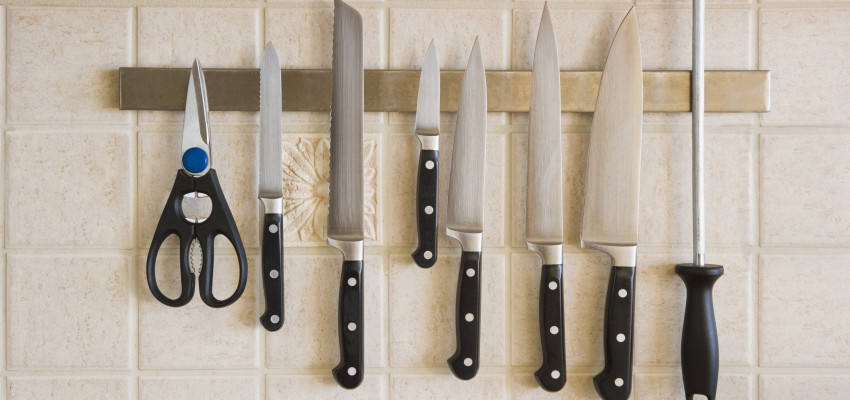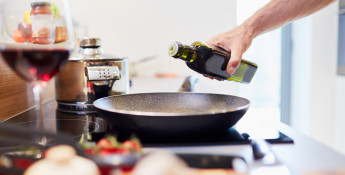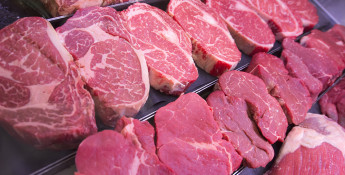By Chef Alli on September 1, 2021
How to Use and Care for Your Chef’s Knife

A good quality chef’s knife can transform daily kitchen tasks and meal prep. If your chef’s knife feels comfortable in your grip, is well cared for and sharp, you can chop ingredients much more quickly and efficiently, helping you conquer dinner with confidence. Use these tips to ensure you’re using your chef’s knife correctly and caring for it properly.
Use your chef’s knife
Because a chef’s knife is wide and long, it can feel intimidating. Fillet knives and paring knives tend to be narrow and flexible so they seem less intense. Just remember, using a small knife for a big job can put the blade under a lot of stress and strain. If you start hacking up hams or carving pumpkins with narrow knife blades, you’ll likely put more pressure on the handle and blade than they’re designed for while adding a lot more work for yourself.
Because a chef’s knife is so versatile, it can be used for dicing vegetables and fruits, chopping nuts and mincing fresh herbs. Many home cooks also use their chef’s knife for slicing meat.
Commit to using your chef’s knife as much as you can so you become comfortable using it. Practice makes perfect. If you need help learning how to correctly hold and use your chef’s knife, find a local culinary store and see if they offer basic knife classes. As an added perk, knife straightening and sharpening of your personal chef’s knife is often included as part of the class. If you can’t attend a class, try YouTube for tutorials on proper chef’s knife use to gain the confidence you need.
Maintain and sharpen your chef’s knife on a regular basis
This may come as a surprise, but it’s true—most people are injured using a dull knife instead of a sharp one. This is because a dull knife requires much more applied pressure to accomplish the kitchen task.
And because more pressure must be applied, it paves the way for the knife to slip, potentially resulting in a deeper cut or injury.
Keep your chef’s knife straight and sharp and it will be an absolute joy to use, making your life in the kitchen much more enjoyable. A honing steel or a handheld honing tool used weekly will keep the blade straight; a good knife sharpener can grind a new edge when needed.
If you aren’t comfortable sharpening your own knives at home, take your knives to a local knife shop for professional sharpening. Depending on how much you use your chef’s knife, it will need to be sharpened at least a couple of times each year.
Don’t make your chef’s knife work too hard
We all love the “chop, chop” sound a chef’s knife makes against our cutting board as we work.
But remember that chopping and dicing need not have a high impact. If your knife is straight (honed) and sharp, you shouldn’t need to work too hard.
To make chopping easier on the blade of your chef’s knife, keep the ingredients on your cutting board piled up (instead of in a flat, single layer) so the blade can cut down through several layers at once.
To steady your chef’s knife as you chop and slice, you can also place your opposite palm on top of the knife blade as you work.
Never use your chef’s knife to open boxes and plastic packaging. That’s one of the quickest ways to remove the sharp edge of the blade. Make sure everyone in the family knows kitchen knives are to be used only for food. Keep box cutters and scissors on hand so they aren’t as tempted to grab your chef’s knife from the knife block.
Let’s talk cutting boards
Any surface that's hard enough not to be damaged by a knife, such as marble, glass, concrete or granite, is hard enough to damage the knife blade. A cutting surface that is too hard for your knife causes the blade edge to fold over, rendering it dull and hard to use.
Wood, bamboo and compressed particle board cutting surfaces “give” to the blade of your knife and won’t cause damage like stone, glass and thin silicone does.
Because most chef’s knives range in length from eight to 12 inches, be sure to use a cutting board that is large enough to comfortably accommodate it and the ingredients you are chopping and slicing.
Size matters
To know if your cutting board is large enough to fully accommodate your chef’s knife, lay it across the board diagonally; if the cutting board is two inches longer at both corners than your chef’s knife, you have the correct size.
No scraping
Another tip: don’t scrape your knife across the cutting board (no matter what type it is) to gather up chopped ingredients. Instead, flip your chef’s knife over and use the spine or a bench scraper (aka pastry scraper), which is designed for the task of scooping and scraping.
Because a bench scraper has a flatter surface than the width of your chef’s knife blade, you will quickly learn why this is such an efficient tool for gathering, lifting and transferring chopped ingredients from your cutting board.
Storing your chef’s knife
Many cooks store their chef’s knife loose in a drawer or utensil jar. Reaching for a cookie dough scoop can end in disaster if you happen to encounter the blade of a knife along the way. Secondly, an unsheathed knife banging against other utensils causes dings and scratches to the blade, which is something we should strive to keep straight and sharp. As nicks and dings pile up on the blade edge, your chef’s knife blade becomes damaged rendering it dull and dangerous very quickly.
Consider securing your knives to a magnetic knife strip or inside a counter knife block. If you’re short on wall and counter space and must store your knives in a utensil drawer, slip them into blade guards first. You can easily make your own inexpensive blade guards from cardboard paper towel rolls that are flattened into knife sheathes. Color code the homemade knife sheathes by wrapping them with bright, fun colors of duct tape for added strength and durability.
Always handwash
Tossing your good kitchen knives into the dishwasher might seem to be the easiest way to clean them, but it’s not. Don’t do it! Dishwasher detergent is quite abrasive, and pressurized spray from the washer arm can take the sharp edge right off your knife blade within just a few washes.
Instead, wash your knives in hot, soapy water. It only takes a minute to handwash your chef’s knife, ensuring it stays sharp, beautiful and damage free. Handwashing your chef’s knife is one of the best ways to keep it in great condition.





